


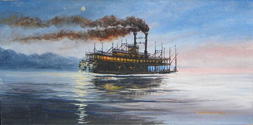
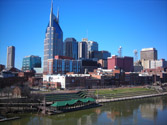
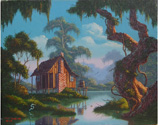
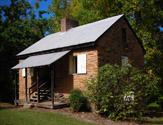









Southern Exposure
Greenville Museum Devotes Exhibition to South Carolina Art and Artists
Particularly renowned for its Southern Collection, the Greenville County Museum of Art has become one of the American South's foremost repositories of visual art. Located at 420 College Street in downtown Greenville, South Carolina, the museum houses works by artists as diverse as Andrew Wyeth, Martin Johnson Heade, George Bellows, Edward Hopper, Jasper Johns, Romare Bearden, Georgia O'Keeffe, Clark Mills and Elaine de Kooning.
The museum's current exhibition, Art and Artists of South Carolina, opened on February 24, 2009. Museum Curator Martha R. Severens, the author of Greenville County Museum of Art: The Southern Collection (New York: Hudson Hills Press, 1995), says the new exhibit "showcases several of our sub collections and also provides an overview of American art history using objects that are related to South Carolina." Regarding the sheer size of the exhibition, Severens states, "This is the first time we have devoted the entire fourth floor to one theme. I think we were all sort of surprised by how much material we have, and we even left out the second half of the twentieth century, except for Jasper Johns!"
Art and Artists of South Carolina reveals the depth and breadth of South Carolina's contributions to the art world as well as the state's ability to attract a variety of painters, sculptors and photographers in search of intriguing subject matter and creative inspiration. Oil pantings, watercolors, sculpture, pottery, photographs and other works on paper are all represented.
Interesting components of the exhibition include historically important pieces like Man in Armor (1726), a pastel by Henrietta Johnston, the first professional female artist in America; Joshua Shaw's oil on paper, View on the Reedy River (ca. 1820), the first known painting of Greenville; Long-billed Curlew (1837), a hand-colored engraving on paper by French-American naturalist John James Audubon; a large alkaline-glazed "poem jar" by slave potter Dave Drake, a piece all the more unique because teaching slaves to read and write was prohibited; and John Ross Key's remarkable portrayal, Bombardment of Fort Sumter, Siege of Charleston Harbor, 1863 (1865).
Twentieth century pieces include the bronze sculpture, Colts Playing (1907), by artist and philanthropist Anna Vaughn Hyatt Huntington who, with her husband Archer Huntington, created the sculpture-laden Brookgreen Gardens in Murrells Inlet, South Carolina; Under the Live Oaks (1937), a watercolor by Andrew Wyeth, who passed away on January 16, 2009 at the age of 91; and the gelatin silver prints, Charleston (1955) by Robert Frank and Child Behind Chainlink Fence (1962) by Bruce Davidson.
Further enhancing the museum's collection are recent acquisitions such as the liberally detailed Southern Plantation (1881), an oil by William Aiken Walker, and Country Church near Beaufort, SC (1935), a gelatin silver print by Walker Evans of Let Us Now Praise Famous Men acclaim.
Perhaps years from now, an exhibition of this sort might include many of today's South Carolina artists, but Severens says, "I regret that we did not have room for more contemporary artists, and we will be addressing that in the future, as that is also another one of our strengths." Noted for its annual Artisphere festival and Pendleton Street Arts District, Greenville -- as well as its surrounding suburbs -- is home to many of the state's most talented artists. Severens relates, "There are many, many upstate artists doing a lot of quality work, and over the years we have had the honor of presenting and acquiring their work."
The museum's current exhibition, Art and Artists of South Carolina, opened on February 24, 2009. Museum Curator Martha R. Severens, the author of Greenville County Museum of Art: The Southern Collection (New York: Hudson Hills Press, 1995), says the new exhibit "showcases several of our sub collections and also provides an overview of American art history using objects that are related to South Carolina." Regarding the sheer size of the exhibition, Severens states, "This is the first time we have devoted the entire fourth floor to one theme. I think we were all sort of surprised by how much material we have, and we even left out the second half of the twentieth century, except for Jasper Johns!"
Art and Artists of South Carolina reveals the depth and breadth of South Carolina's contributions to the art world as well as the state's ability to attract a variety of painters, sculptors and photographers in search of intriguing subject matter and creative inspiration. Oil pantings, watercolors, sculpture, pottery, photographs and other works on paper are all represented.
Interesting components of the exhibition include historically important pieces like Man in Armor (1726), a pastel by Henrietta Johnston, the first professional female artist in America; Joshua Shaw's oil on paper, View on the Reedy River (ca. 1820), the first known painting of Greenville; Long-billed Curlew (1837), a hand-colored engraving on paper by French-American naturalist John James Audubon; a large alkaline-glazed "poem jar" by slave potter Dave Drake, a piece all the more unique because teaching slaves to read and write was prohibited; and John Ross Key's remarkable portrayal, Bombardment of Fort Sumter, Siege of Charleston Harbor, 1863 (1865).
Twentieth century pieces include the bronze sculpture, Colts Playing (1907), by artist and philanthropist Anna Vaughn Hyatt Huntington who, with her husband Archer Huntington, created the sculpture-laden Brookgreen Gardens in Murrells Inlet, South Carolina; Under the Live Oaks (1937), a watercolor by Andrew Wyeth, who passed away on January 16, 2009 at the age of 91; and the gelatin silver prints, Charleston (1955) by Robert Frank and Child Behind Chainlink Fence (1962) by Bruce Davidson.
Further enhancing the museum's collection are recent acquisitions such as the liberally detailed Southern Plantation (1881), an oil by William Aiken Walker, and Country Church near Beaufort, SC (1935), a gelatin silver print by Walker Evans of Let Us Now Praise Famous Men acclaim.
Perhaps years from now, an exhibition of this sort might include many of today's South Carolina artists, but Severens says, "I regret that we did not have room for more contemporary artists, and we will be addressing that in the future, as that is also another one of our strengths." Noted for its annual Artisphere festival and Pendleton Street Arts District, Greenville -- as well as its surrounding suburbs -- is home to many of the state's most talented artists. Severens relates, "There are many, many upstate artists doing a lot of quality work, and over the years we have had the honor of presenting and acquiring their work."
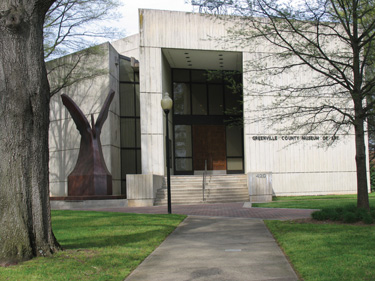
As far as categorization, some South Carolina art is strictly regional, just as some southern literary works fall into the category of sectionalism. However, South Carolina art is hardly limited to romanticized landscapes depicting moss-draped live oak trees, black sharecroppers or Charleston's Rainbow Row. When asked if many South Carolina artists have gained national prominence, Severens replies, "Yes, two come directly to mind. William H. Johnson and Jasper Johns have national reputations. They both transcended their roots and established uniquely personal artistic vocabulary. The exhibition also features artists who have done work in South Carolina, including the well-known American scene painter Edward Hopper."
Colorful Complements
Complementing the exhibition are three installations -- Jasper Johns: Just Thinking of a Series of Dreams; Charleston Renaissance; and William H. Johnson: Native Son.
Jasper Johns: Just Thinking of a Series of Dreams is an autobiographical display of paintings, watercolors and prints by Johns whose work since 1983 has begun to reflect more on his South Carolina childhood. Largely self-taught, Johns was born in Augusta, Georgia in 1930 and attended the University of South Carolina and a commercial art school in New York before entering military service in 1951. Johns and his colleague, Robert Rauschenberg, served as the bridge between Abstract Expressionism and the fashionable Pop Art and Minimalism of the 1960s. Today, Johns resides in Connecticut. This exhibit, which includes his iconic Flags I (1973), can be viewed until September 27, 2009.
Scheduled to run until September 6, 2009, Charleston Renaissance is dedicated to what Severens describes as "the period of renewal between 1915 and 1940 that brought Charleston from being a sleepy rundown town to a major tourist destination as we know it today." Severens explains, "This reshaping of Charleston was largely the result of artists and writers who put Charleston on the map, as it were, by 'packaging' the city. Several local women -- [including] Alice Huger Ravenel Smith and Elizabeth O'Neill Verner -- tended toward quasi-romantic portrayals. Other artists, mostly men from the outside, were often more straightforward and less likely to gloss over the tired streetscapes, and they also saw the life of the local population, especially the blacks, in more realistic terms." Charleston Renaissance represents the period well, offering a sampling from all of the key figures. "I think we have one of the strongest Charleston Renaissance collections, not all of which is up, and ours is broader than the one at the Gibbes [Museum of Art in Charleston]," Severens points out.
William H. Johnson: Native Son, running until October 4, 2009, is an installation dedicated to one of South Carolina's most important African American artists. Born in Florence, South Carolina, a railroad hub and farming community in 1901, Johnson's plight would mirror that of other southern African Americans. Moving to New York at the age of 17, Johnson performed menial jobs to support himself as he studied art at the National Academy of Design. He also became an assistant to Ash Can School painter George Luks. During his career, he would travel to various European cities, including Paris, Florence, Hamburg, Cologne, Copenhagen, Oslo and Kerterminde (Denmark), before returning to New York in 1938 due to the rise of Nazism. Johnson's European works contrast sharply with his later paintings. This exhibition, a virtual paradigm of Johnson's career, includes some of his expressionistic landscapes as well as exciting, colorful scenes painted during his time in New York's vibrant Harlem community.
Creating a Richly Layered Canvas
The Greenville County Museum of Art is a pinnacle in a region where a variety of important museums and collections abound. "We have charted a course which is different from our sister museums, in part because we have different audiences, but also we have devoted a lot of our resources to building the collection whereas others are more exhibition driven," Severens remarks.
Colorful Complements
Complementing the exhibition are three installations -- Jasper Johns: Just Thinking of a Series of Dreams; Charleston Renaissance; and William H. Johnson: Native Son.
Jasper Johns: Just Thinking of a Series of Dreams is an autobiographical display of paintings, watercolors and prints by Johns whose work since 1983 has begun to reflect more on his South Carolina childhood. Largely self-taught, Johns was born in Augusta, Georgia in 1930 and attended the University of South Carolina and a commercial art school in New York before entering military service in 1951. Johns and his colleague, Robert Rauschenberg, served as the bridge between Abstract Expressionism and the fashionable Pop Art and Minimalism of the 1960s. Today, Johns resides in Connecticut. This exhibit, which includes his iconic Flags I (1973), can be viewed until September 27, 2009.
Scheduled to run until September 6, 2009, Charleston Renaissance is dedicated to what Severens describes as "the period of renewal between 1915 and 1940 that brought Charleston from being a sleepy rundown town to a major tourist destination as we know it today." Severens explains, "This reshaping of Charleston was largely the result of artists and writers who put Charleston on the map, as it were, by 'packaging' the city. Several local women -- [including] Alice Huger Ravenel Smith and Elizabeth O'Neill Verner -- tended toward quasi-romantic portrayals. Other artists, mostly men from the outside, were often more straightforward and less likely to gloss over the tired streetscapes, and they also saw the life of the local population, especially the blacks, in more realistic terms." Charleston Renaissance represents the period well, offering a sampling from all of the key figures. "I think we have one of the strongest Charleston Renaissance collections, not all of which is up, and ours is broader than the one at the Gibbes [Museum of Art in Charleston]," Severens points out.
William H. Johnson: Native Son, running until October 4, 2009, is an installation dedicated to one of South Carolina's most important African American artists. Born in Florence, South Carolina, a railroad hub and farming community in 1901, Johnson's plight would mirror that of other southern African Americans. Moving to New York at the age of 17, Johnson performed menial jobs to support himself as he studied art at the National Academy of Design. He also became an assistant to Ash Can School painter George Luks. During his career, he would travel to various European cities, including Paris, Florence, Hamburg, Cologne, Copenhagen, Oslo and Kerterminde (Denmark), before returning to New York in 1938 due to the rise of Nazism. Johnson's European works contrast sharply with his later paintings. This exhibition, a virtual paradigm of Johnson's career, includes some of his expressionistic landscapes as well as exciting, colorful scenes painted during his time in New York's vibrant Harlem community.
Creating a Richly Layered Canvas
The Greenville County Museum of Art is a pinnacle in a region where a variety of important museums and collections abound. "We have charted a course which is different from our sister museums, in part because we have different audiences, but also we have devoted a lot of our resources to building the collection whereas others are more exhibition driven," Severens remarks.
Courtesy Greenville County Museum of Art
Reproduction is not permissible.
Reproduction is not permissible.
The Greenville County Museum of Art
Situated at 420 College Street on downtown Greenville's Heritage Green, the Greenville County Museum of Art is highly regarded in a region that includes Atlanta's High Museum of Art, New Orleans' Ogden Museum of Southern Art, Augusta's Morris Museum of Art and Charleston's Gibbes Museum of Art. Designed by the local architectural firm of Craig, Gaulden & Davis, the modernist building is complemented by Mountain Flight (1978), a steel sculpture by Richard Hunt.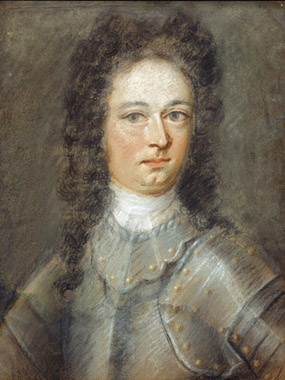
Courtesy Greenville County Museum of Art
Reproduction is not permissible.
Reproduction is not permissible.
Man in Armor (1726), pastel,
Henrietta de Beaulieu Dering Johnston
Henrietta de Beaulieu Dering Johnston
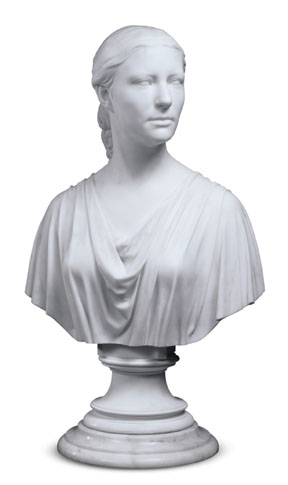
Courtesy Greenville County Museum of Art
Reproduction is not permissible.
Reproduction is not permissible.
Catherine M. Hampton (1849-1851),
carved marble bust, Hiram Powers
carved marble bust, Hiram Powers
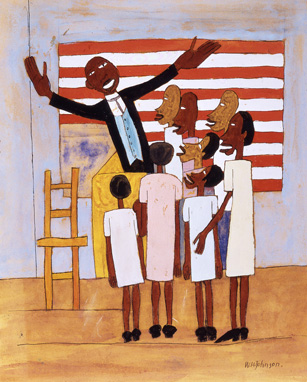
Courtesy Greenville County Museum of Art
Reproduction is not permissible.
Reproduction is not permissible.
Lift Up Thy Voice and Sing (circa 1942-1943), oil,
William H. Johnson
William H. Johnson
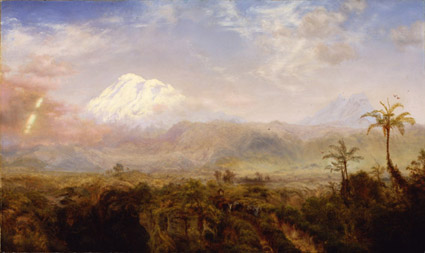
Courtesy Greenville County Museum of Art
Reproduction is not permissible.
Reproduction is not permissible.
Mount Chimborazo (circa 1865), oil,
Louis Rémy Mignot
Louis Rémy Mignot
Supported by the local community, the museum in turn serves the community by exposing its visitors, who range from school-age youngsters to veteran artists, to a world of art that might otherwise be accessible only in major metropolises like Atlanta, New York, Philadelphia, Chicago or San Francisco. When asked what patrons might expect to experience or glean from the current exhibition, Severens replied, "It is a lesson in history, but it is also an aesthetic journey. It is broad and deep and varied and, I think, something for everyone's taste. Some of it is nostalgic, some challenging."
Art and Artists of South Carolina will be on view until January 3, 2010. As always, admission to the museum is free.
The author gratefully acknowledges the assistance of Greenville County Museum of Art Curator Martha R. Severens and Communications Manager Mary C. McCarthy.
BIBLIOGRAPHY
Martha R. Severens. Greenville County Museum of Art: The Southern Collection (New York: Hudson Hills Press, 1995).
Martha R. Severens. The Charleston Renaissance (Spartanburg, South Carolina: Saraland Press, 1998).
Author: Greg Freeman. Published March 13, 2009.
Art and Artists of South Carolina will be on view until January 3, 2010. As always, admission to the museum is free.
The author gratefully acknowledges the assistance of Greenville County Museum of Art Curator Martha R. Severens and Communications Manager Mary C. McCarthy.
BIBLIOGRAPHY
Martha R. Severens. Greenville County Museum of Art: The Southern Collection (New York: Hudson Hills Press, 1995).
Martha R. Severens. The Charleston Renaissance (Spartanburg, South Carolina: Saraland Press, 1998).
Author: Greg Freeman. Published March 13, 2009.
Copyright
Southern Edition
All Rights Reserved
Southern Edition
All Rights Reserved
All materials contained on this site, including text and images, are protected by copyright laws and may not be reproduced without prior written permission from the publisher. Where applicable, use of some items contained on this site may require permission from other copyright owners.
Fair Use of text from SouthernEdition.com is permitted to the extent allowed by copyright law. Proper citation is requested. Please use this guide when citing a Southern Edition article.
Contact Greg Freeman or SouthernEdition.comFair Use of text from SouthernEdition.com is permitted to the extent allowed by copyright law. Proper citation is requested. Please use this guide when citing a Southern Edition article.